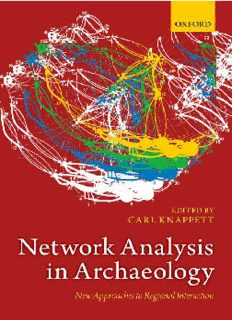
Network Analysis in Archaeology: New Approaches to Regional Interaction PDF
Preview Network Analysis in Archaeology: New Approaches to Regional Interaction
NETWORK ANALYSIS IN ARCHAEOLOGY This page intentionally left blank Network Analysis in Archaeology New Approaches to Regional Interaction Editedby CARL KNAPPETT 1 3 GreatClarendonStreet,Oxford,OX26DP, UnitedKingdom OxfordUniversityPressisadepartmentoftheUniversityofOxford. ItfurtherstheUniversity’sobjectiveofexcellenceinresearch,scholarship, andeducationbypublishingworldwide.Oxfordisaregisteredtrademarkof OxfordUniversityPressintheUKandincertainothercountries #OxfordUniversityPress2013 Themoralrightsoftheauthorshavebeenasserted FirstEditionpublishedin2013 Impression:1 Allrightsreserved.Nopartofthispublicationmaybereproduced,storedin aretrievalsystem,ortransmitted,inanyformorbyanymeans,withoutthe priorpermissioninwritingofOxfordUniversityPress,orasexpresslypermitted bylaw,bylicenceorundertermsagreedwiththeappropriatereprographics rightsorganization.Enquiriesconcerningreproductionoutsidethescopeofthe aboveshouldbesenttotheRightsDepartment,OxfordUniversityPress,atthe addressabove Youmustnotcirculatethisworkinanyotherform andyoumustimposethissameconditiononanyacquirer BritishLibraryCataloguinginPublicationData Dataavailable ISBN 978–0–19–969709–0 PrintedbytheMPGPrintgroup,UK Acknowledgements Thisvolumearisesfromasessionorganizedatthe75thAnniversaryMeeting oftheSocietyforAmericanArchaeologyatStLouis,Missouri.Iwouldliketo thankallthespeakersatthesessionforrespondingtomyinvitation,andthen being so professional in promptly converting their oral papers into written chapters for this publication. Ray Rivers covered for me when at the last minute I was unable to make the trip to St Louis. Indeed, Ray has been an incrediblyinformativeandpatientinterlocutorformyresearchintonetworks fornearlyadecadenow,ashashiscolleagueatImperialCollege,TimEvans. I am extremely grateful to both of them. Elena Soboleva gamely took on the challenge of producing a cover image, and I thank her warmly. At Oxford University Press, Hilary O’Shea and Taryn Das Neves have once again been incrediblyhelpfulandaccommodating. This page intentionally left blank Contents ListofContributors ix FiguresandTables xv PartI: Background 1. Introduction:whynetworks? 3 CarlKnappett 2. Socialnetworkanalysisandthepracticeofhistory 17 JohnEdwardTerrell 3. ‘Owhatatangledwebweweave’—towardsapracticethat doesnotdeceive 43 LeifIsaksen PartII: SitesandSettlements 4. Brokenlinksandblackboxes:materialaffiliationsand contextualnetworksynthesisintheVikingworld 71 SørenM.Sindbæk 5. Positioningpowerinamulti-relationalframework:asocialnetwork analysisofClassicMayapoliticalrhetoric 95 JonathanB.Scholnick,JessicaL.Munson,andMarthaJ.Macri 6. Whatmakesasiteimportant?Centrality,gateways,andgravity 125 RayRivers,CarlKnappett,andTimEvans 7. Evolutionofprestigegoodsystems:anapplicationofnetworkanalysis tothetransformationofcommunicationsystemsandtheirmedia 151 KojiMizoguchi PartIII: MaterialCulture 8. ThedynamicsofsocialnetworksintheLatePrehispanic USSouthwest 181 BarbaraJ.Mills,JohnM.RobertsJr.,JefferyJ.Clark,William R.HaasJr.,DeborahHuntley,MatthewA.Peeples,LewisBorck, SusanC.Ryan,MeaghanTrowbridge,andRonaldL.Breiger 9. Socialnetworks,pathdependence,andtheriseofethnicgroups inpre-RomanItaly 203 EmmaBlake viii Contents 10. Re-thinkingJewishethnicitythroughsocialnetworkanalysis 223 AnnaCollar 11. Groundingthenet:socialnetworks,materialculture,and geographyintheEpipalaeolithicandearlyNeolithicofthe NearEast((cid:2)21–6,000calbce) 247 FionaCoward 12. Evaluatingadaptivenetworkstrategieswithgeochemical sourcingdata:acasestudyfromtheKurilIslands 281 ErikGjesfjeldandS.ColbyPhillips 13. OldboynetworksintheindigenousCaribbean 307 AngusMolandJimmyMans PartIV 14. Archaeology,networks,informationprocessing,andbeyond 335 SandervanderLeeuw Index 349 List of Contributors EmmaBlake isAssistantProfessorintheSchoolofAnthropology,University of Arizona, USA. An archaeologist who studies Italy in the second and first millennia bce, her doctoral dissertation focused on monumentality on Sar- diniaintheBronzeAge.Sheconductsfieldworkinnorth-westSicily,currently as co-director of the Marsala Hinterland Survey, an intensive field survey alongthecoastadjacenttothePhoeniciancolonyofMotya.Sheisalsowriting abookonsocialnetworksandemergentethnicitiesinpre-RomanItaly. Lewis Borck is a PhD student in the School of Anthropology, University of Arizona, USA. He studies forms of resistance in the archaeological record, often by focusing on the social, cultural, and spatial interactions of marginal groupswiththeirmorepowerfulneighbours.Heisalsointerestedincombin- ing GIS and social network analysis. His master’s research applied these theoretical and methodological interests to the Gallina region of the prehis- toricNorthAmericanSouthwest. RonaldL. BreigerisProfessorintheDepartment ofSociology,Universityof Arizona. His interests include social networks, adversarial networks, stratifi- cation,mathematicalmodels,theory,andmeasurementissuesinculturaland institutionalanalysis. JefferyClarkhasbeenaPreservationArchaeologistatArchaeologySouthwest inTucsonforoveradecade.HereceivedhisPhDandMAfromtheUniversity of Arizona and his BA from Cornell University. Dr Clark’s research has focusedonassessingthescaleandimpactof humanmigration.Hehasspent the past twenty years studying late pre-contact migrations in central and southern Arizona. During the 1990s, he supervised large contract projects in this region as project director for Desert Archaeology, Inc. Dr Clark has also workedextensivelyinsouth-westAsia,includingIsrael,Syria,andIraq. Anna Collar is a Fellow of the McDonald Institute for Archaeological Research, University of Cambridge. Her doctoral dissertation explored the spread of religious innovations across military, ethnic, and belief-based networks in the Roman empire. The expanded and revised version is under review at Cambridge University Press. She has recently organized an international conference on networks: The Connected Past: People, Net- works and Complexity in Archaeology and History. Fiona Coward teaches at Royal Holloway, University of London. Her work focuses on cognitive and social evolution and its impact on cultural
Description: